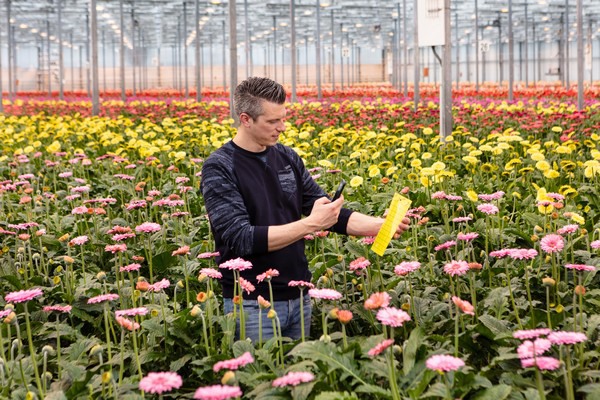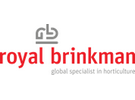They didn't invent the term ICM at Royal Brinkman. It already exists, and WUR is also researching it. What Royal Brinkman is now doing together with partners and growers is giving the concept of Integrated Crop Management a practical application for greenhouse horticulture, with special attention to data and digital techniques.
And focusing on successes already achieved, by making changes in one of the 15 knowledge areas in the ICM system approach. After all, crop protection is no longer just 'reaching for the sprayer when something has gone wrong'.
This image is still very much alive in the social and political debate. People know the flowers in the bouquet weren't grown without pesticides, and they have strong opinions about it. The sector has to deal with this. "The sector doesn't have as strong a voice like some other large companies," says Thomas Kern, Business Development & Strategy Manager at Royal Brinkman. He focuses on sustainable growth and Integrated Crop Management (ICM).

Not more expensive
The greenhouse industry has already taken many steps. Communicating this well to consumers is proving difficult. Data and success stories can help. Royal Brinkman wants to contribute in both areas. The transition to resilient cultivation must be faster, especially now that social and political pressure on crop protection products is increasing.
With the ICM system approach introduced this autumn, Royal Brinkman is taking a broader look at solving crop protection problems. The system approach developed combines 15 areas of knowledge with data.
The broad-spectrum chemical crop protection products that growers used to be able to rely on are increasingly disappearing or are already non-existent. There are fears that with new means, including for example the preventive use of biological control agents, it will become more expensive to control diseases and pests.
Thomas, who is also a board member at sector organizations Artemis and Agrodis, recognizes the perception that with adjustments in crop protection, cultivation can also become more expensive. "Yet this is not always the case, especially if you can work with good data." With precision crop protection, it is possible to treat only a specific corner of the greenhouse with a crop protection product, instead of the entire greenhouse.
Data
For precision crop protection, reliable data is essential. The industry can also learn from good data. With converting data into value, the sector is still in the early stages, Thomas notes. "We notice that there is still often a lack of good data to take steps with digital crop protection. Significantly more data is needed to steer effectively in cultivation."
Royal Brinkman also introduced the digital data analysis platform Auxin this spring. The platform makes it possible to make connections between data modules and between hitherto often fragmented data. The first growers started using Auxin this year.
Collecting data takes time, Thomas realises. The growers who started working with Auxin were already working with the app MyScout. The app is an alternative to the traditional notepad and paper assignment for the crop protection specialist.
Unlike a cursory piece of paper, the data collected through MyScout persists and is of great value. "The key now is to invest in quality data for successful Integrated Crop Management in the future. In a few years, you will start seeing the effects of the efforts we are making now."

MyScout, in use by grower Hans van Holstein
Small successes
However, growers don't have to wait that long. With the right interventions, they can achieve success even now thanks to the ICM system approach. For example, mechanical measures, such as installation of insect netting, can reduce pest pressure in the greenhouse. More and more growers are opting to mesh their greenhouses.
But is it 'failure' if a pest insect causes problems despite this measure? No. What matters is the system approach. In all 15 knowledge areas from the ICM approach, growers can often still make strides.
In recent years, the idea of crop protection has increasingly moved from curative to preventive. The next step is 'from prevention to prediction'.
The scout data from MyScout is combined in the Auxin platform with other greenhouse measurements so that the advice in the Advice Generator is specifically tailored to the unique conditions in one's greenhouse. This creates personalized and situation-specific advice that is directly linked to the grower's measurement results. Thomas stresses that we are not there yet: the automatic link between MyScout, Auxin, and the Advice Generator is still under development. We are working hard to make this possible soon.
Rapid technological developments are forcing Royal Brinkman to change course regularly. What initially seemed a promising solution may soon be overtaken by new techniques with higher effectiveness. "This constant adapting brings challenges, especially in convincing users of the value and reliability of the latest technologies."
Getting used
Developing such advanced systems requires significant investment, something the entire industry needs to get used to. "Traditionally, we are used to a more stable innovation process, but rapid technological progress now requires a different approach and mindset. For a company like Royal Brinkman, with origins as a trading company, this means a switch to thinking in terms of long-term investments and bearing development costs."
Choosing an ICM system approach raises the question of what is currently the weakest link. "Although it may seem obvious, this often turns out to be people themselves. And by that I mean everyone involved in in systems thinking, from development to implementation and use."
Thomas gives the example of the Advice Generator, which is fed with more and more data. "As a result, crop protection advice is getting better and better. Still, the advice can sometimes differ from what specialists or growers are used to, which can initially lead to doubts about the technology."
The belief that 'green fingers' can do more than technology can sometimes get in the way of technical progress, notes the Business Development & Strategy Manager. "Cameras and sensors are a good example of this; they really can now perceive much more than we humans can. The crux lies in what we do with these observations."
Time
For the transition that greenhouse horticulture is in, it is important to start relying on modern technologies. However, it is not the only condition for a successful transition to resilient cultivation. "Shrinking the resource package should also not happen too fast. Investing in new techniques takes time. In the interim phase, however, resources must remain available to properly tackle diseases and pests."
Thomas cites the registration of Biocontrol, also known as 'green agents', as an example. Registration takes a long time. The industry is not moving fast enough. This spring, cherry growers therefore ran into problems.
Another example Thomas knows from tomato cultivation, and the fight against Tuta absoluta. "This pest can be brought under control with the help of monitoring with pheromones. The next challenge will be Tomato Looper. Here, too, a similar system approach can help, but the long authorization procedures are again an obstacle."

Read more about Auxin in an article published this spring.
Competition
Most of the 15 knowledge areas in the ICM range do not cover crop protection products. The whole is more complex. Royal Brinkman explicitly invites other companies from all the knowledge areas involved to collaborate on the ICM course. But will that invitation be accepted?
Thomas acknowledges that cooperation between many parties in this new reality can be challenging because of competition. "Besides the existing network of knowledge partners and companies, more and more new companies are joining to collaborate on ICM. You can work well even with formerly competing companies, provided everyone declares their interests and is willing to look for the common denominator." Growers also have a role to play in this. They often already cooperate with several parties and can encourage cooperation between different parties.
In the field of digital scouting, developments with the latest technologies are now moving fast. Small successes are important to motivate participants to continue efforts, starting with data collection. Royal Brinkman has taken the first steps with partners and growers, and that makes Thomas positive. "Initiative from the sector itself is most effective. It is more easily embraced that way."
For more information:
Thomas Kern
Royal Brinkman
[email protected]
www.royalbrinkman.nl/icm
